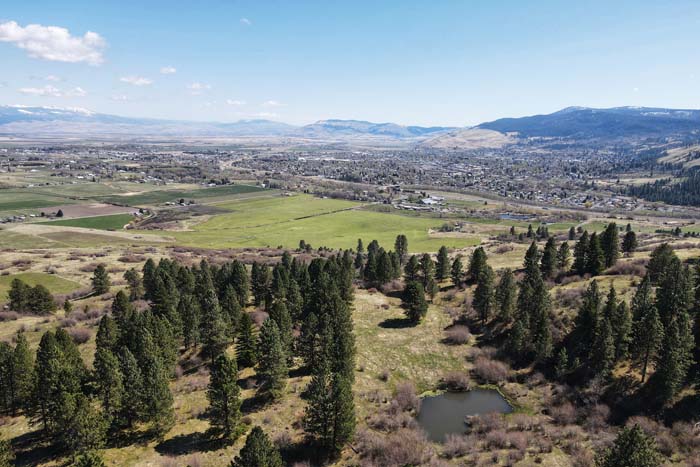Union County sees slim population growth in 2020 census
Published 7:00 am Saturday, August 14, 2021

- Mount Emily Recreation Area overlooks the city of La Grande on April 18, 2021. Union County is hosting a public field review of the upcoming Red Apple area management project on Wednesday, Nov. 10, at noon at MERA’s Owsley Canyon Trailhead.
UNION COUNTY — The Census Bureau released the 2020 census on Thursday, Aug. 12, revealing that Union County grew in population by 1.7%.
The population expanded from 25,748 in 2010 to 26,196 in 2020, an increase of 448 residents. Union County is listed as the 23rd largest county out of the 36 in Oregon, while its 1.7% population increase was the fifth smallest growth in the state.
“The census is very important because it is what guides us for the next 10 years when it comes to funding and income needs, among other things,” Union County Commissioner Donna Beverage said.
The 2020 census was the 24th census to be taken in the U.S. and marked the first time that individuals could respond online.
Local numbers
The population census from April 1, 2020, reported that the city of La Grande’s population stands at 13,026, a slight decrease from the 13,082 reported in 2010. Of that 2020 calculation, 88.6% are white and 52.8% are female.
Portland State University released a database that showed Cove saw a drastic increase, jumping 12.3% from 552 to 620. North Powder saw another rather large population increase — 14.8%.
Union increased by only 1.5%, and Elgin saw a 0.4% rise in population. Imbler was the single city in Union County to decrease in population according to the census, dropping from 306 to 245.
In Baker City, the population from the census increased from 9,828 in 2010 to 10,099 in 2020. However, based on population estimates from 2010 to 2020, the population decreased by 0.2% from 2010 to 2019.
Pendleton’s population grew from 16,612 in 2010 to 17,107 in the 2020 census. Based on population estimates, the city’s population increased by 1% from 2010 to 2019.
According to Charles Rynerson, coordinator of the Oregon State Data Center at Portland State University, Oregon saw a large number of new residents from other states and other countries.
“In most Oregon counties there were more deaths than births, (and) that’s only going to accelerate,” he said. “In order to stave off loss, those counties will be expected to move more people in than out.”
Housing update
A number of cities, including La Grande, are under a housing shortage, which was reflected in the census results. The county ranked 24th in Oregon in housing unit vacancy rate, a tool used to measure the percentage of available housing. This measurement calculates the percentage of vacant or unoccupied units in a region. The rate for the county is 7.5%, an increase of 1.4% since 2010.
According to La Grande City Manager Robert Strope, the census numbers will have little impact on the city’s housing plans moving forward, but census numbers can impact population-based funding.
“We just finished a pretty comprehensive housing needs analysis and adopted a housing production strategy that looks specifically at La Grande and our needs,” he said. “The sampling that is done through the census isn’t going to be nearly as helpful as the stuff we’re doing in-house.”
Neighboring counties
Two of Union County’s adjoining neighbors, Umatilla and Wallowa counties, both saw identical increases of 5.5%. Umatilla County created a complete count committee in 2018 with the mission of ramping up efforts to acquire an accurate count in the census. Additionally, Umatilla County Commissioner George Murdock is one of six commissioners in the U.S. who serves on the National Association of Counties Census 2020 Working Group.
Morrow County experienced the largest population growth from 2010 to 2020 out of any county in Eastern Oregon, expanding 9.1% to 12,186. In Southern Oregon, Grant County was the only county in the state to experience a population decrease based on census data.
Census participation
In Union County, census participation efforts were delegated to individual cities. Strope noted that funding from the national level, such as the American Rescue Plan Act of 2021, can see changes based on population totals.
“A number of our funding sources are based on population, so it’s really important to have as accurate of a population count as we can through the census,” he said.
Each person in a county brings in $3,200 per year in federal government payments, which illustrates the importance of responding to the census. According to the Census Bureau, the government funding based on the census is directed toward roads, fire departments, health clinics and more.
“We very much encouraged people to do their census, it was a high priority for Union County,” Beverage said.
The 2020 census was the first to be available online, but the pandemic still caused issues, according to Beverage. Obstacles also arose in North Powder and Union, where mail is delivered to post office boxes instead of direct mail. The census forms also were sent to households via email, but not all residents have internet access.
According to Rynerson, mailing issues in Eastern Oregon communities were a focus of emphasis during the 2020 census.
“In places where people get their mail at post offices, it was a big concern,” Rynerson said. “Hopefully they were able to follow up with those households, but it was a concern.”
Since the census is not mailed through post office boxes, the Census Bureau uses other methods such as dropping questionnaires at the doors of households in communities where people utilize the post office to get their mail.
“It was a little harder with the pandemic, not being able to knock on doors and that kind of thing,” Beverage said. “It took a lot longer, but we put notices out and worked around it. The efforts were definitely hindered by COVID.”




